The G.Skill KM780 Mechanical Keyboard & MX780 Gaming Mouse Review
by E. Fylladitakis on November 4, 2015 8:00 AM EST- Posted in
- G.Skill
- Peripherals
- Mouse
- Cherry MX
- Mechanical Keyboards
The Unified Driver System Software
Software is a very important parameter for high end gaming peripherals such as these. G.Skill named their software the "Unified Driver System" and, much like most similar software packages, it can identify and setup either or both of the KM780 and the MX780. Still, although the interface of the software remains the same, the driver package for each individual device needs to be installed separately.
The main layout of the package is very similar regardless of the device connected. There are three main settings tabs (Customize, Setting & Lighting) and two tabs for the programming of macros and lighting profiles. Macros and lighting effects need to be programmed individually before programming the keyboard. To the top right corner, three small buttons give access to the software settings, the warranty terms and a link to the company's web page.
The Customize section is the main programming section of either the keyboard or the mouse. To the left, there are options for the creation of profiles, with up to three different modes per profile for the keyboard. Profiles and modes are programmed independently and different profiles can be sharing modes. They can also be linked to a software, automatically switching when that software launches. There are no mode programming options available for the mouse.
Per-key programming is available for both the keyboard and the mouse. Any key can be programmed to execute virtually any command, from a typical single-key function of another key (layout change) to the execution of external programs and macros. It can also be programmed to insert a piece of text, such as a repetitive/common guild chat message or a piece of programming code, or to be disabled altogether.
More options are offered in the case of the mouse, as the user can also program DPI switch, "sniper" and profile switch functions. For those unaware of what the "sniper" key does, it reduces the DPI of the mouse significantly while the key is being held pressed, allowing on-the-fly precise aiming while gaming.
The Setting section is, with the exception of a single setting, different for the keyboard and the mouse. The only setting available for both devices is the control of the polling rate, which can be set between 125 Hz and 1000 Hz. If there are no compatibility issues, there is no reason why anyone should reduce the polling rate of either device.
For the keyboard, the user can also adjust the repeat rate delay and acceleration, how alerts are displayed (OSD or lighting effects on the keyboard) and the programming of a "sleep mode". There also is an option to change the n-key rollover to 6-key rollover (only six concurrent keypresses will register) but, once again, there is no real reason to do so unless there are serious compatibility problems with your system.
As for the mouse, the Setting section offers DPI programming options, some control over the lift range of the mouse and control over the double click/wheel scroll/pointer speeds. The user can program between one and five DPI levels, with different X and Y axis sensitivity if required.
The Lighting section, as the name suggests, allows for the programming of the devices' lighting. There are options to select between solid lighting and lighting effects, for all of the keys or individual keys. Do not forget that the lighting effects have to be programmed via the Lighting Profiles tab before they can be inserted into individual keys or groups. By default, 24 colors are available, but these can be programmed via the lighting profiles section.
The Lighting Profiles section offers two main options: to change the default 24 colors and to program basic lighting effects. Only two effects are available for the mouse, Cycle and Breathe. The Wave, Ripple and Reactive effects are only available for the keyboard, naturally, as they would have no real meaning on the mouse. Strangely, the Cycle effect is not available for the keyboard, although it would work just fine.
By far the most important section of any such software is the macro recorder and, unfortunately, this is the weakest link of these products. Regardless whether the macro is being programmed for the keyboard or the mouse, the macro recorder can only register button presses/clicks and delays. These delays can then be edited and custom keypresses can be manually inserted. However, without the ability to record any kind of mouse movements, relative or absolute, the macro recording software is useless to nearly all gamers. We can think of very few situations where mouse movements are not necessary for in-game macros and chances are that even these users will require a macro including mouse movements at some other point of the same game. It is certain that advanced gamers will have to result to third party macro programming software, compile .EXE files and then program keys to launch them as external applications.
What the software also needs is some language editing, as we have adjectives mixed with nouns on the tabs/buttons and some other language-related errors.


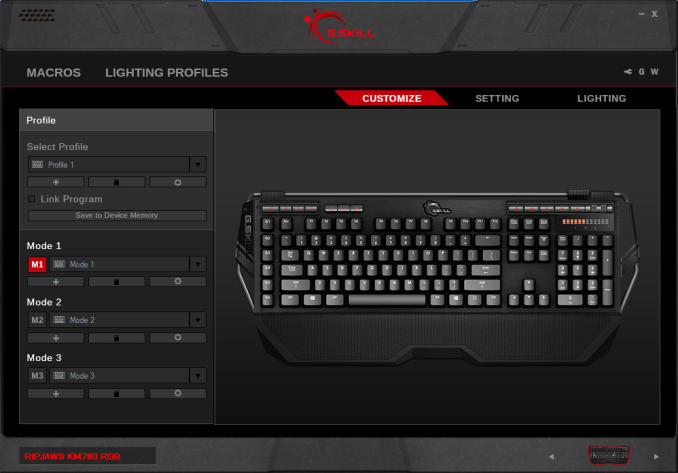
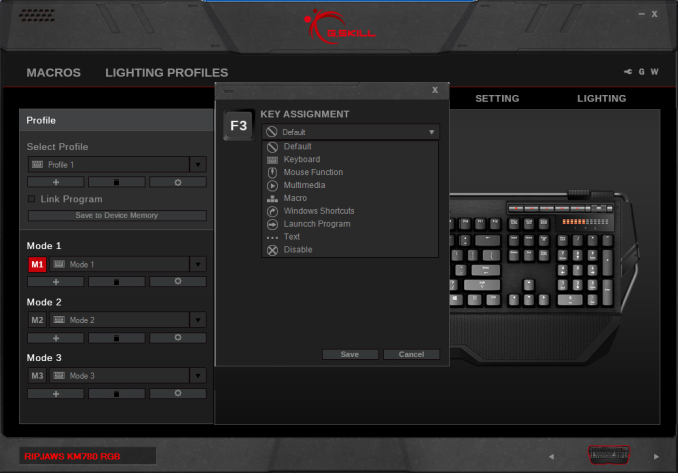
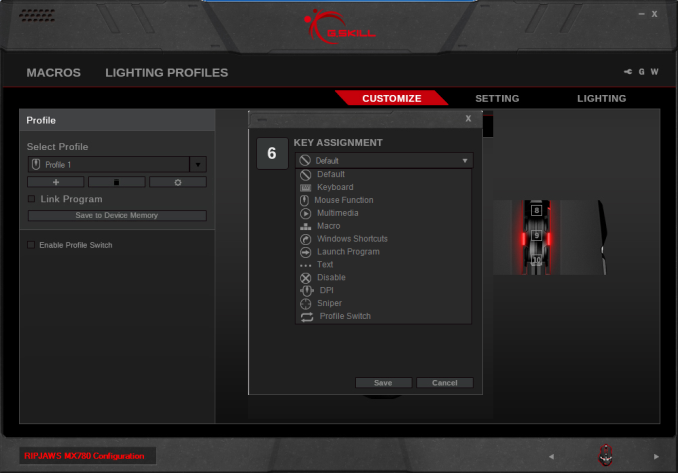
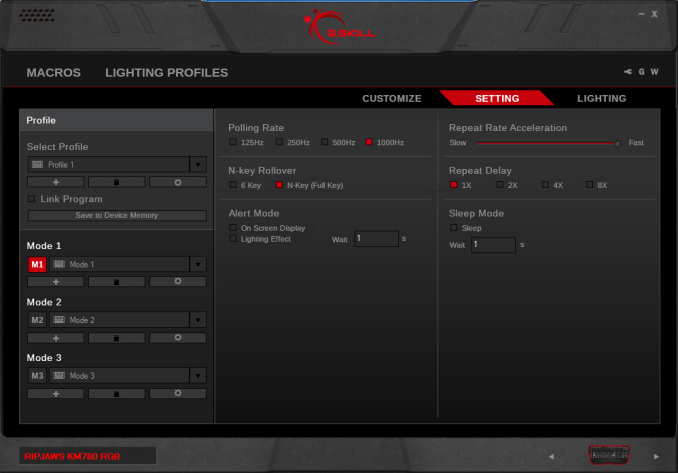

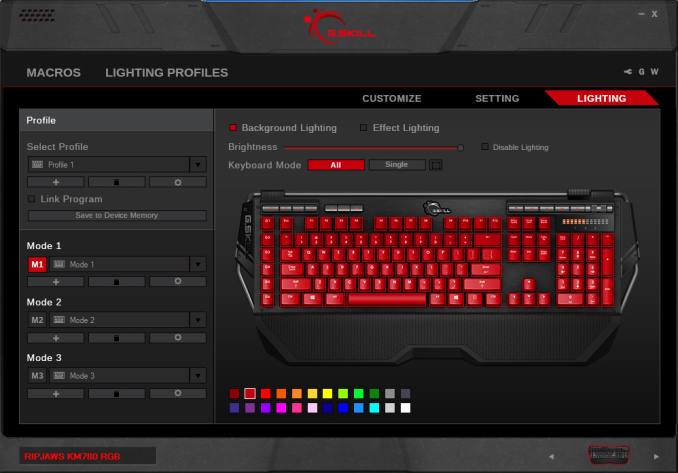
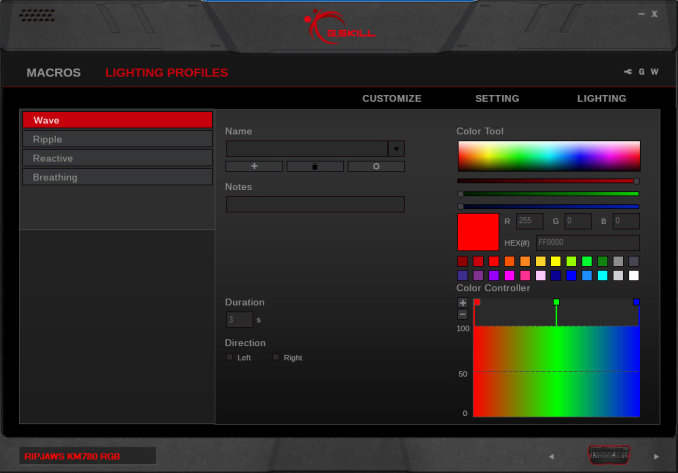
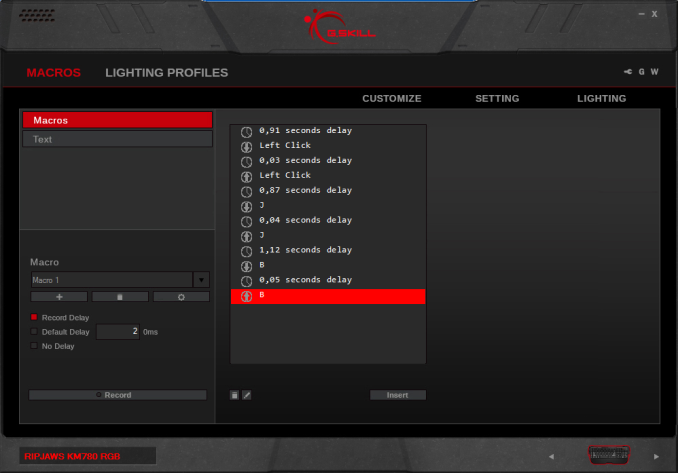








33 Comments
View All Comments
techfreshness - Friday, November 6, 2015 - link
me too man, they actuate and reset faster as well. can't speak to the durability vs cherry mx's though, those aren't true gaming switches imo, invented in the 80's lolFriendly0Fire - Wednesday, November 4, 2015 - link
Towards the medium/high end, Corsair's keyboards are pretty sweet (and come with MX Browns, among others). I have the K95 RGB, which I love, but the K70 is essentially the same with less fluff.mastercheif91 - Wednesday, November 4, 2015 - link
I'm surprised you outright claim that Cherry RGB switches provide the best lighting experience. While most vastly prefer the typing experience from the Cherry switches, the Logitech Romer-G switch lighting theoretically is a much better solution. Having the lighting tube built into the key stem seems to be a much more efficient method of lighting key caps than merely turning the entire housing translucent.Manch - Wednesday, November 4, 2015 - link
yay another keyboard.....so...about that Surface Book review?Stuka87 - Wednesday, November 4, 2015 - link
You do know that different people review different items?Manch - Wednesday, November 4, 2015 - link
Oh I thought all the articles were written by one guy like at DT...Manch - Wednesday, November 4, 2015 - link
Or perhaps I was just expressing my disappointment about yet another filler article.metayoshi - Wednesday, November 4, 2015 - link
Umm... Welcome to Anandtech, I guess? It's the one reason I stay attached to Anandtech. They don't just review the big name consumer products out there like the Samsung Galaxy S6's, iPhone 6s's, Surface Pro 4s, and Macbook Pros, they review the little niche market segments like random cases and power supplies and gaming accessories like mice and keyboards. They review things like NAS boxes and SSDs, not just the latest and greatest CPUs from Intel/AMD and the latest and greatest GPUs from Nvidia/AMD. As an enthusiast like me who likes to build PCs every few years, Anandtech is a godsend of a website, and it's articles like these that help me when I need a new keyboard, or a new SSD, or a new NAS box. I can get reviews of the big products on a billion different websites, though not of the same quality as Anandtech, and I can usually form my own opinion about those products from those other websites, but for PC components, Anandtech is still one of the only places for quality reviews.Manch - Thursday, November 5, 2015 - link
Good lord people....so sensitive...Joy-Energiser - Thursday, November 12, 2015 - link
Good lord you're an idiot, go troll another article.